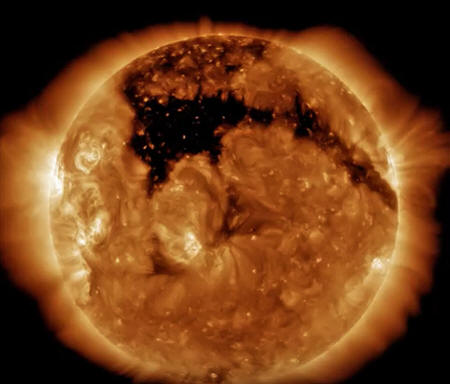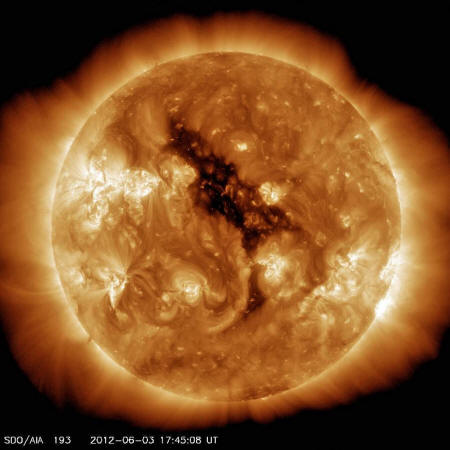|
by Evan Gough
NASA's Solar Dynamics Observatory has captured images of a growing dark region on the surface of the Sun. Called a coronal hole, it produces high-speed solar winds that can disrupt satellite communications.
Image: Solar Dynamics Observatory
/ NASA
NASA has spotted an enormous black
blotch growing on the surface of the Sun. It looks eerie, but this
dark region is nothing to fear, though it does signal potential
disruption to satellite communications.
The lack of plasma in these holes is what makes them appear dark. Coronal holes are the origin of high-speed solar winds, which can cause problems for satellite communications.
The images were captured by the Solar Dynamics Observatory (SDO) on July 11th (2016).
Tom Yulsman at Discover's ImaGeo blog created a gif from several of NASA's images:
High-speed solar winds are made up of solar particles which are travelling up to three times faster than the solar wind normally does.
Though satellites are protected from the solar wind, extremes like this can still cause problems.
Coronal holes may look like a doomsday warning; an enormous black hole on the surface of our otherwise placid looking Sun is strange looking. But these holes are a part of the natural life of the Sun.
And anyway, they only appear in extreme ultraviolet and x-ray wavelengths.
The holes tend to appear at the poles, due to the structure of the Sun's magnetosphere. But when they appear in more equatorial regions of the Sun, they can cause intermittent problems, as the high-speed solar wind they generate is pointed at the Earth as the Sun rotates.
In June 2012, a coronal hole appeared that looked Big Bird from Sesame Street.
The "Big Bird" coronal hole appeared on the Sun in June 2012. It was the precursor to a powerful storm that was considered a near miss for Earth. Image: NASA/AIA
The Big Bird hole was the precursor to an extremely powerful solar storm, the most powerful one in 150 years.
Daniel Baker, of the University of Colorado's Laboratory of Atmospheric and Space Physics, said of that storm,
We were fortunate that it missed us, as these enormous storms have the potential to damage power grids on the surface of the Earth.
It seems unlikely that any solar wind that reaches Earth as a result of this current coronal hole will cause any disruption to us here on Earth. But it's not out of the question.
In 1989 a solar storm struck Earth and knocked out power in the province of Quebec in Canada. It may be that the only result of this coronal hole, and any geomagnetic storms it creates, are more vivid auroras.
Those are something everyone can appreciate and marvel at.
And you don't need an x-ray satellite to see them...
|



